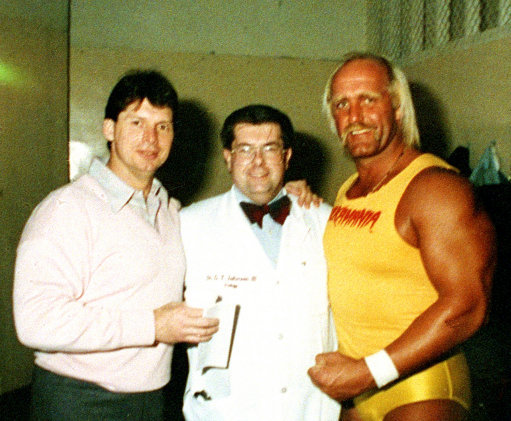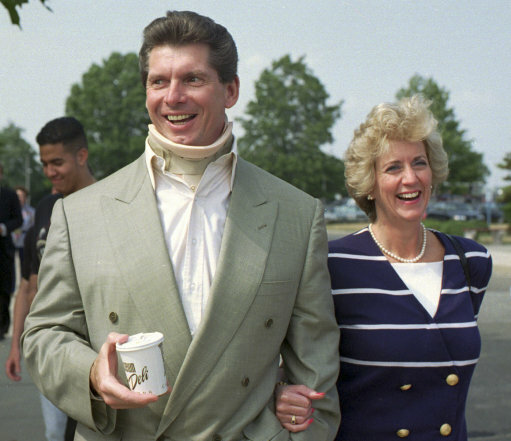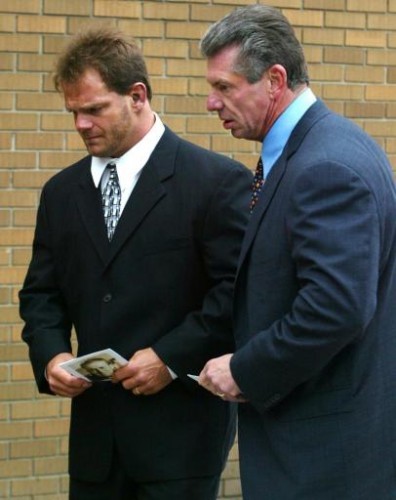This article originally ran on 28 May, 2014 and we’ve republished it here in light of the recent death of former WWE wrestler, Chyna. She was 45.
IN JULY 1994, Terry Gene Bollea walked into a federal courtroom on Long Island and talked openly about steroid use in professional wrestling. He described how it had all started for him.
It was the middle of 1976.
Anabol, decagabril, testosterone. Injectables. Orals.
According to Bollea, 80% of wrestlers used steroids.
There was a doctor, George Zahorian, in Pennsylvania who went to the taping of wrestling shows, met with performers and distributed various drugs. Steroids, sleeping pills, diet pills, Tylenol 3 and Tylenol 4. He would take blood tests. He would carry a medical bag and two boxes filled with drugs.
Bollea would call Emily Feinberg and ask her to place an order on his behalf. Emily Feinberg was the then-executive secretary to Vince McMahon.
Terry Gene Bollea was (and still is) better known by his stage-name, Hulk Hogan. He had been granted immunity if he testifed at McMahon’s trial. In his autobiography, Hogan refers to McMahon as “a cocky son of a bitch who didn’t give an inch”.
Hogan sat in court and presented a picture of professional wrestling as a place where those that ran the sport couldn’t care less about the health and well-being of their employees. Where those that ran the sport actively promoted the use of illegal substances. Where those that ran the sport ordered those illegal substances. Where those that ran the sport, upon hearing Zahorian was under investigation, asked wrestlers not to call the doctor or use him for fear of the feds finding out.
McMahon, the wrestling king-pin, the promoter and performer, who owned what was then the World Wrestling Federation (WWF), was called a “corporate drug pusher” by the prosecution.
But, the trial collapsed and McMahon was acquitted. Hogan was relieved. He hadn’t set out to do his friend. In his book, he wrote:
“I saw what Vince was going through. It was hell.”
*
In June 2007, Chris Benoit, a former World Championship Wrestling (WCW) and WWF champion hanged himself in the weight room of his house. He was 40.
Prior to committing suicide, he had killed his wife and his son. The doctors who examined Benoit’s body said his heart was so enlarged, he would’ve died naturally within ten months. The Sports Legacy Institute examined Benoit’s brain. They said it resembled that of an 85 year-old Alzheimer’s sufferer.
McMahon’s WWE (the follow-on from WWF) said steroids “were not and could not” be related to Benoit’s death. The toxicology report said otherwise. Benoit had taken a litany of substances. He had ten times the normal amount of testosterone in his body. But he was also on painkillers and Xanax. He was hooked. Unsurprisingly, he was painted as a lunatic, a loose cannon, someone who snapped.
In fact, he was a damaged individual suffering with long-running mental health problems and working in a job where drug abuse was widespread.
When the full details surrounding Benoit’s death emerged, McMahon, imaginatively, called him a ‘monster’. It fit the narrative. McMahon played the role perfectly. He damned Benoit and, rather conveniently, erased him from wrestling history.
Two years previously, Benoit’s best friend – another wrestler, Eddie Guerrero, died at 38 from heart failure. He had a history of drug abuse. Eleven days before his death, he picked up a cocktail of them – testosterone and nandrolone as well as anastozole – an oestrogen-blocker. They were all prescribed by a Florida physician, Gary Brandwein. It was all tied to a steroid ring and a list of wrestlers, including Randy Orton, were caught up in the investigation.
*
In 2012, WWE celebrated a milestone. The 1000th episode of weekly TV show RAW.
Long-term critic of McMahon, the New York Post sportswriter, Phil Mushnick, pondered how the party would play out. Maybe, he wondered, the organisation would offer a roll call of its former employees who died before they reached forty-five, the majority of them troubled by substance abuse problems that began during their WWF/WWE years?
Nah. Not enough time.
Mushnick has called the wrestling environment ”a death mill”. It’s hard to disagree. Benoit’s death made headlines – notably because he’d murdered his family. If he’d only killed himself, he’d have been like all the others – just another name to add to an already expansive list (there’s so many, a website was set up to keep track).
But Benoit is now infamous. There’s an edge to his story, a darkness that’s easy to analyse. But what about all the others? What about their darkness? What about their inner turmoil, their dependency on drugs? Their mental health?
For those that died, like Guerrero, on the nondescript bathroom floors of nondescript hotel rooms, what can be said? ‘Oh, what a tragedy’. ‘He went too young’. The details are too much like hard work. The general public aren’t interested beyond the headline. Why was he juiced up? Why had he become dependent on drugs? Why, at thirty-eight, with a wife and three children, was he still so determined to not be left behind? To keep up the fantasy?
Vince McMahon has dodged the bullets for a long time. He has survived the attempts to take him down. He’s pleaded ignorance and refused to take responsibility for his role in contaminating professional wrestling. Instead, he’s continued to head-up a multi-million dollar industry that peddles make-believe and pushes entertainment.
But it’s come at the expense of real people with real problems who needed real help.
Author’s note: Original comments on this article have been removed to avoid confusion.




